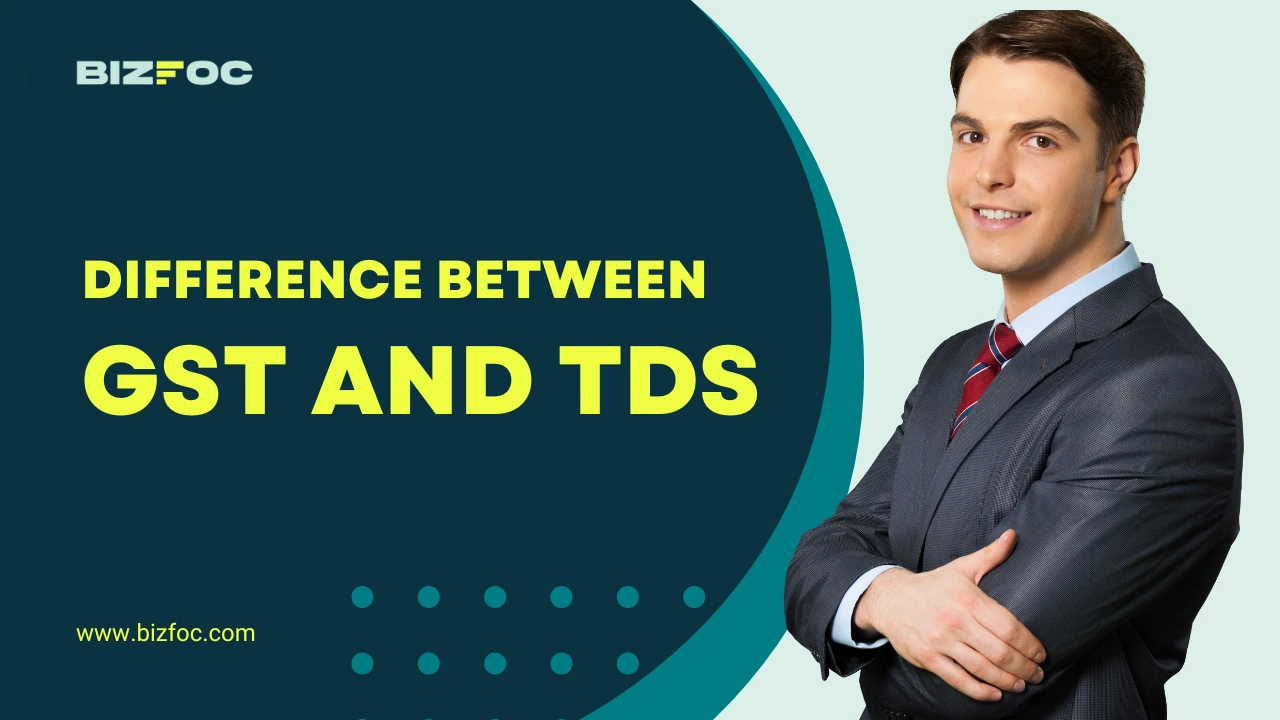Publishing Date: 04 Nov, 2024

Updated on November 21, 2024 02:03:34 PM
Tax Deducted at Source (TDS) and Goods and Services Tax (GST) are two distinct components of the tax system. TDS is an income tax collected at the source of income, ensuring that tax is deducted from payments such as salaries, interest, and rent before they reach the recipient. This mechanism helps prevent tax evasion and allows individuals to receive credit for the deducted amounts when filing their tax returns. In contrast, GST is a consumption tax applied to the sale of goods and services, aimed at creating a unified tax structure by merging various indirect taxes. It is charged at different rates depending on the type of goods or services and allows businesses to claim input tax credits for GST paid on purchases. While TDS focuses on income tax collection at the source, GST is concerned with taxing consumption at various stages of the supply chain.
Read this blog to navigate the key differences between GST and TDS.
Tax Deducted at Source (TDS) is a mechanism used by governments to collect tax at the source of income. Essentially, it means that when a payment is made (like salary, interest, rent, etc.), a certain percentage of that payment is deducted by the payer as tax before it reaches the payee. The deducted amount is then remitted to the government.
For example, if you earn a salary, your employer may deduct TDS from your pay and submit it to the tax authorities on your behalf. This ensures that tax is collected throughout the year rather than in a lump sum at the end of the financial year.
TDS rates vary depending on the type of income and the applicable laws in the jurisdiction. It helps in reducing tax evasion and ensures a steady flow of revenue for the government.
GST refers to “Goods and Services Tax”. This Act was passed in the parliament on 29th March, 2017 and came into effect in India on 1st July, 2017. This is the single, comprehensive, and indirect tax, which is applicable only to goods and services. The GST is divided into 3 categories which includes CGST, SGST/UTGST and IGST. GST is levied on the supply of goods and services. GST is a destination based tax which is levied on every value addition.
Before the emergence of GST (Goods and Services Tax), there were various types of indirect taxes that needed to be paid at every point of production and distribution of goods.
Here is the key differences between GST and TDS, which are as follows:
|
Parameters |
GST (Goods and Services Tax) |
TDS (Tax Deduction at Source) |
|
Nature |
Indirect Tax |
Direct Tax |
|
Purpose |
To tax the supply of Goods and Services |
To collect tax at the source of income |
|
Meaning |
GST is an indirect tax that is paid on the production, consumption, and sales of goods and services. |
Tax Deduction at Source is tax that is deducted at the source of income of an individual or business. |
|
Applicability |
This is applicable to all businesses whose turnover exceeds ₹40 Lakhs (in case of goods) & ₹20 Lakhs (in case of service) |
The TDS is applicable on various sources of incomes: salary, commission, brokerages, etc. |
|
Payer entity |
GST is paid by the consumer of goods and services and GST is remitted to the government by the supplier of goods and services. |
TDS is deducted and deposited by the payer of income on the behalf of the payee of income. |
|
Collection Point |
Collected at the point of sale of Goods and supply of Services |
Deducted from the payments made |
|
Responsibility |
Supplier (seller) is responsible for collection |
Deductor (Payer) is responsible for deduction |
|
Rates |
Multiple rates (0%, 5%, 12%, 18%, 28%) |
TDS rates varies because of payment type and recipient |
|
Mechanism of Payment |
By using Challan GST-PMT 06, the supplier can pay the GST electronically. |
TDS is deposited electronically using TRACES website. |
|
Impact |
Suppliers of Goods and services can claim Input Tax Credits against Gst payments |
Tax can be claimed by the deductee at the time of filing income tax return |
GST implications on Business
The implementation of GST (Goods and Services Tax) has several implications for businesses. Here are some of the key impacts:
Unified Tax Rate: GST replaces multiple indirect taxes, simplifying compliance and making tax calculations more straightforward.
Elimination of Cascading Taxes: By allowing input tax credits, GST reduces the tax burden on businesses, promoting fair pricing.
Credit for Taxes Paid: Businesses can claim credit for the GST paid on inputs, which can significantly reduce the overall tax liability.
Improved Cash Flow: Input tax credits can improve cash flow by reducing the effective tax paid.
Increased Compliance: Businesses need to maintain detailed records and file GST returns regularly, which can increase administrative burdens.
Technology Adoption: Many businesses have to adopt or upgrade accounting systems to ensure compliance with GST rules.
Competitive Pricing: With the removal of cascading taxes, businesses can potentially lower prices, enhancing competitiveness.
Transparent Pricing: GST promotes transparency in pricing, as consumers can see the tax breakdown on invoices.
Interstate Trade: GST facilitates smoother interstate trade by eliminating state-level taxes (like octroi) and barriers, encouraging businesses to expand their market reach.
E-commerce Growth: Simplified tax regulations have made it easier for e-commerce companies to operate across states.
TDS Implications on Business
The implementation of TDS (Tax Deducted at Source) has several implications for businesses. Here are the key impacts:
Immediate Tax Deduction: TDS is deducted at the time of payment, which can impact a business's cash flow. Companies need to plan their finances accordingly.
Tax Liability Visibility: Businesses can have clearer visibility of their tax liabilities throughout the year.
Record Keeping: Businesses must maintain detailed records of all payments subject to TDS and ensure accurate deductions.
Regular Filings: Companies are required to file TDS returns periodically, which can increase administrative workload.
Compliance Penalties: Non-compliance with TDS provisions can lead to penalties, interest on late payments, and other legal issues.
TDS Certificates: Businesses must issue TDS certificates to vendors, which, if not managed properly, can lead to disputes or compliance issues.
Tax Credits: Businesses can use TDS as a credit against their income tax liabilities, impacting overall tax planning and cash flow.
Link with GST: While TDS and GST are separate, businesses need to ensure that both tax regimes are correctly accounted for, which can complicate compliance.
There are two different taxes in the Indian taxation system. One is GST and the other is TDS, which are considered as the main components under the government tax revenue. GST removes the cascading effects of taxes, while TDS considers various types of income when exceeding the threshold limit prescribed in various sections. So it is interesting to learn about the difference between GST and TDS to get more familiarity with the taxation policy of India. Understanding these is crucial for effective financial planning and strategic decision-making.
1) How can I check my TDS credits?
You can check your TDS credits through Form 26AS, which is available on the Income Tax Department’s website.
2) How often do I need to file TDS returns?
TDS returns must typically be filed quarterly, depending on the type of deductor and payments made.
3) What are the different types of payments subject to TDS?
There are numerous payments which are subjected to TDS deductions like salaries, interest, rent, professional fees, brokerage, royalty, commissions etc.
4) Can TDS be deducted on exempt supplies under GST?
No, TDS (Tax Deducted at Source) cannot be deducted on exempt supplies under GST.

e-Shram Card: Registration| Apply online| Download
25 Nov, 2024

7th Pay Commission Pay scales- Bizfoc
23 Nov, 2024

What Is Actuarial Valuation Of Gratuity?
23 Nov, 2024

8th Pay Commission | Fitment Factor Salary Hikes | Bizfoc
23 Nov, 2024

Top 12 Best Future Business Ideas That Will Boom in 2050
21 Nov, 2024
Share article via:
